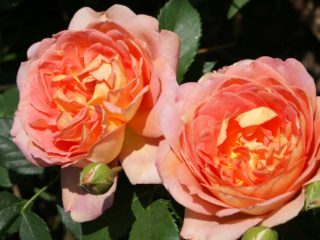Content
Climbing rose Amadeus is an irreplaceable plant for vertical gardening, decoration of columns, arches. Many growers grow it on balconies and terraces. Despite its youth, the variety is popular.
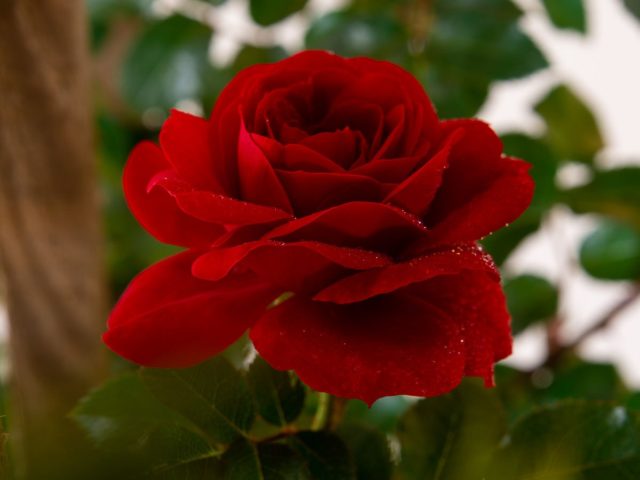
Climbing rose Amadeus blooms until the first frost
Breeding history
The originators of the climbing rose Amadeus are German breeders "Kordes". The plant was received in 2003. Thanks to the efforts of the creators, the Amadeus variety has acquired an amazing aroma, which contains raspberry, cherry and apricot notes.
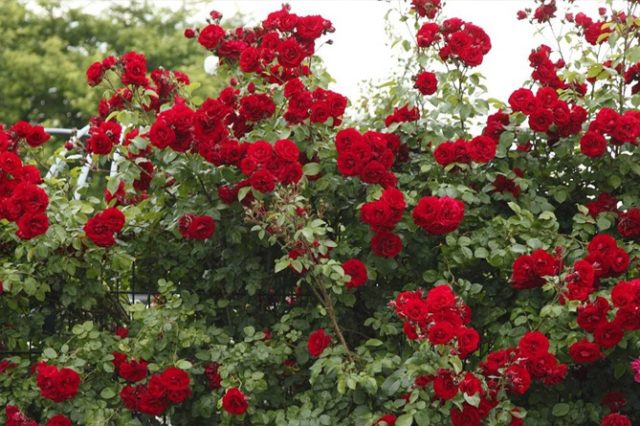
Climbing rose Amadeus is the owner of international certificates and awards
Description and characteristics of the climbing rose variety Amadeus
The climbing rose Amadeus, the photo and description of which is presented below, according to the reviews of florists, is an excellent option for creating flower arrangements. They can be planted singly or in combination with different garden plants.
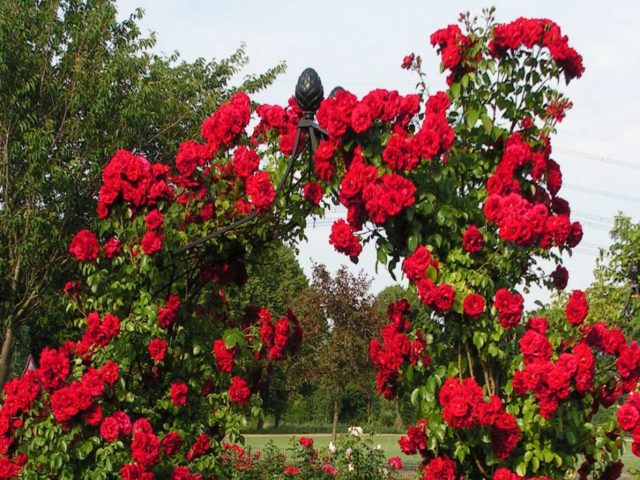
Climbing Amadeus produces original arches
Description of the bush
The variety stands out among other rose bushes for its vigor and tallness. As a rule, the length of the lashes is on average 3-4 m. Florists who have been cultivating for more than one year, in the reviews, note that the climbing rose Amadeus requires support, since the plant constantly forms side branches, which makes the bush heavy.
There are many crooked thorns on the bright green shoots. They are very sharp.
Flowers
The climbing rose Amadeus, which is well shown in the video, refers to varieties with double flowers. Each dense, elongated bud has up to 42 petals. The inflorescence is strong, lush, it contains up to 7 large roses, the diameter of which varies within 12 cm. The petals are of a rich red hue.
After flowering, the buds have a raspberry overflow, then they become burgundy.
Blooming of remontant rose bushes is not only long-lasting, the buds bloom in two waves, 1.5 months each. Single flowers appear between them on Amadeus. Therefore, it seems that the climbing rose does not stop forming buds throughout the summer.
The plant is frost-resistant, withstands temperatures up to -30 ° C without much loss. But only if long climbing shoots are cut off before wintering, and the remaining ones are bent to the ground and covered.

Climbing rose Amadeus can be grown as a standard crop
Why buds do not form
Unfortunately, it is not always possible to observe a lush bloom. Although this does not happen often, gardeners should be aware of the reasons. Rare flowers or their complete absence on the climbing rose Amadeus can be associated with:
- with a lack of lighting;
- with a lack of food, since a powerful bush requires a lot of them;
- with diseases of rose bushes or when attacked by insects;
- with incorrect or untimely pruning;
- with the need to transplant rose bushes.
On which shoots does the Amadeus rose bloom?
As already noted, improper pruning of a climbing rose can lead to rare flowering or none at all. That is why it is important to know which shoots should be left behind.
The climbing rose Amadeus forms buds along the entire length of the shoots of the last year, which overwintered successfully. It is on them that the first wave of flowering occurs. Such shoots should be left at least 3-5 pieces. They are not pruned in the fall, in the spring only the apical underdeveloped buds are removed.
The second wave of flowering occurs on the replacement shoots.
Since there are a lot of them on climbing bushes, in order to protect plants from diseases and pests, some must be cut out.
Advantages and disadvantages of the variety
To understand whether it is possible to plant a new plant on the site, and most importantly, whether it will be possible to properly care for it, you need to know not only the description. It is important to consider the advantages and disadvantages of the variety.
First you need to find out the advantages of the climbing rose Amadeus (Amadeus). Thanks to the efforts of German breeders, it has:
- abundant and prolonged flowering from the beginning of summer until the first frost;
- an interesting color palette of petals that can change color;
- the ability to develop and form buds in partial shade;
- powerful root system;
- good immunity, powdery mildew rarely appears on the plant.
If we talk about the shortcomings, according to gardeners who have been cultivating for more than one year, the climbing rose Amadeus has only one drawback - a large number of sharp thorns.
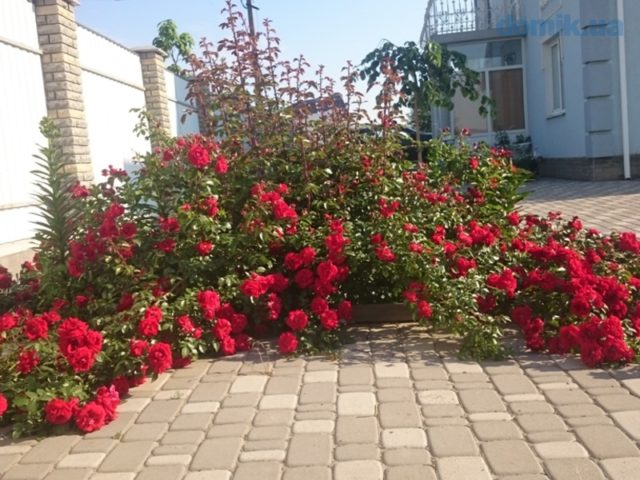
If you lower the lashes of the Amadeus variety to the ground, then you can use it as a ground cover plant.
Reproduction methods
Climbing rose Amadeus is propagated at home using layering. In May, when the soil warms up well, a young shoot is bent down at the mother bush, fixed and sprinkled with soil. Water abundantly during the summer. When a good root system is formed, the seedling is transplanted to a permanent place.
Growing and care
The climbing rose Amadeus is considered an unpretentious culture. But without proper care, no plant, including this variety, will be able to develop normally and please with abundant flowering.
Planting timing, site and soil selection
The German climbing rose is planted in both spring and fall. It is not forbidden to place container seedlings in a permanent place even in summer. For planting, you need a loose, well-fertilized soil.
For planting climbing varieties, an elevation is chosen; groundwater should not come close to the surface. Otherwise, problems with the root system will begin. In the place where the Amadeus rose will grow, there should be natural shading so that the sun's rays do not burn the flowers and leaves.
Seedling preparation
After inspection, the roots, long shoots and branches are pruned at the seedling. Before planting, the roses are dipped into a biostimulator. The mixture is prepared from mullein, 2 tablets of phosphorobacterin and clay. They are dissolved in 10 liters of water.
Landing rules
Planting the climbing rose variety Amadeus is not difficult. All stages are almost identical.
Planting sequence:
- dig a hole 50x50x50 cm;
- lay drainage;
- cover 2/3 with nutritious soil;
Fresh manure under the climbing rose Amadeus is not recommended to be added
- make a tubercle in the center and place a seedling, straightening the roots;
- sprinkle with earth;
In order not to deepen the vaccination site, you can use a measuring stick.
- form a near-stem circle, water, add mulch.
As a protective layer, you can use not only humus, but also straw, fresh cut grass
Watering and feeding
Watering the climbing rose variety Amadeus should be abundant, since it is a moisture-loving plant. Nitrogen fertilizers are used as top dressing (in spring); during the flowering period, food should contain phosphorus and potassium. It is advisable to add superphosphate before wintering.
Pruning
When pruning the climbing rose Amadeus, you need to be careful.This concerns overgrowth regulation. As flowers form on last year's shoots. It is necessary to leave 3-5 shoots of different ages. In the fall, old branches are cut, and the summer growth cannot be touched.
Shelter for the winter
In autumn, after the end of flowering, the lashes are removed from the support and laid on the ground. When the temperature drops below -6 degrees, they proceed to the shelter, having performed preliminary pruning. Dry leaves or spruce branches are poured on top. In the conditions of the Urals or Siberia, boxes, non-woven material are placed on the bushes. In winter, sprinkle with snow.
Pests and diseases
Despite its resistance to diseases, the climbing rose Amadeus still needs to be sprayed for prevention with antifungal agents. You can use the preparations "Skor", "Maxim", "Quadris", "Aktara".
Purchase special preparations for pest control.
Application in landscape design
The climbing variety is appreciated by landscape designers.

This unique plant is almost not afraid of the neighborhood of garden crops.
Options for the location of the rose in the landscape:
- On lawns singly or in groups.
- Several varieties with red or pink hues.
- Near evergreens and conifers.
- Use trees and shrubs as support, but they should not grow intensively.
- Decorate arches, balconies, terraces.
Conclusion
Climbing rose Amadeus is distinguished by the beauty of velvety buds. She enjoys well-deserved popularity among Russian flower growers.









